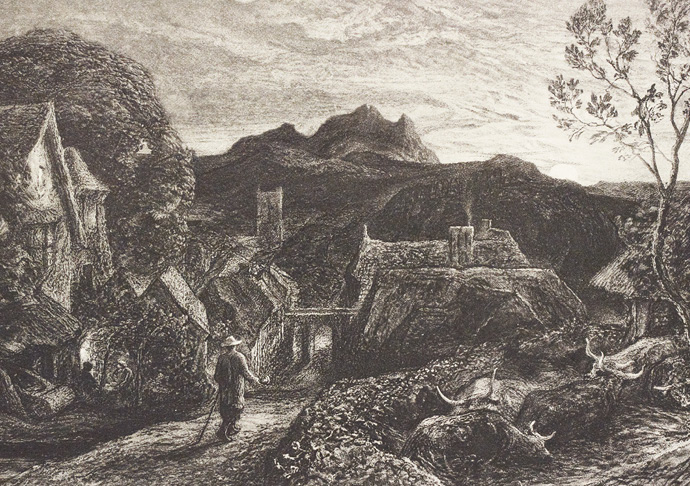This article is taken from PN Review 280, Volume 51 Number 2, November - December 2024.
Pictures from the Rylands LibraryOn Reading Milton in Samuel Palmer

‘The Bellman’ by Samuel Palmer from The Shorter Poems of John Milton, 1889. (Image © The John Rylands Research Institute and Library, The University of Manchester, 2024)
A drawing of an old house or a house seen in an old print may be a ‘reliable document that leaves its mark on a biography, [but] daydreams return to inhabit such a drawing for no dreamer ever remains indifferent for long to a picture of a house’. As Gaston Bachelard observes, asking someone to draw a house is tantamount to inviting them to ‘reveal the deepest dream shelter they have found for their happiness [for] houses are the embodiment of home and each one of their nooks and corners is a resting place for dreaming’.
As old prints go, the houses in the one shown here by Samuel Palmer exert an almost archetypal power to prompt such oneiric meditations as they nestle together in a knot enveloped in deepening dusk. Their windows glimmer, reflecting glowing hearths, the feet of their inhabitants upon the fenders and smoke curling from the chimneys. As light fades, only the bellman’s gentle benediction interrupts this ‘awed still reverie [which] conjures an awareness of life’s fragile mysteries and a wistful yearning for a greater reality beyond’ (Rachel Campbell-Johnston). Considered by some to be the greatest artistic expression of Palmer’s oeuvre, this image, part of a group made late in life through the disciplined medium of etching, is credited with the rekindling of the ‘visionary spirit of his art’ (William Pressly). So acting as a portal, the old house allows the artist to ‘inhabit the universe [and] the universe to inhabit the old house’.
Yet, in the 1860s when Leonard Rowe Valpy first commissioned work from Palmer, no stipulation was made concerning houses, only an appeal to encourage the artist’s ‘inner sensibilities’. What Palmer chose to produce was a suite of watercolours and etchings inspired by John Milton’s poems ‘L’Allegro’ and ‘Il Penseroso’. He told Valpy,
‘I have often dreamed the daydream of a set of subjects from these poems’, but had previously been forced to abandon the project for fear of failing to match Milton on equal terms.
But since the poets speak from the ‘threshold of being’ (John Stilgoe), their poems must, by definition, assume certain house-like qualities, for they provide homes where readers and their imaginations might dwell. In Palmer’s case the poetry of Milton was as much his ancestral home as the house he was born in, as from childhood he read the poems with a devotional fervour that lasted the length of his life. Having been instilled with reverence for the poet’s verse by his nurse and cherished mother figure Mary Ward (CampbellJohnston), he would carry her Tonson’s Pocket Milton in his pocket for more than twenty years as his preferred walking companion. In coming to know Milton’s poems by heart, their ‘images stocked his artistic imagination, [and] sonorous rhythms stirred the depths of his soul’ (Pressly). And by living in and through these poems he finally achieved his ‘fain hope’ to create a body of work worthy of Milton, that would ‘live when I am with the fallen leaves’ (Palmer).
This article is taken from PN Review 280, Volume 51 Number 2, November - December 2024.




